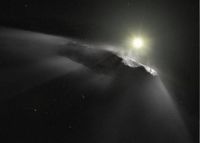There’s a new cosmic guest in our neighborhood, and it’s stirring up excitement—and, to be honest, a fair bit of speculation. The object in question is 3I/ATLAS, a newly confirmed interstellar comet that’s been racing through the inner solar system since its discovery on July 1, 2025, by the NASA-funded ATLAS survey. Just a day after, the Minor Planet Center officially confirmed its interstellar status, making this only the third such visitor observed by humanity, after 1I/ʻOumuamua in 2017 and 2I/Borisov in 2019, according to NASA Science and the Minor Planet Center.
What’s so special about 3I/ATLAS? For starters, its trajectory and speed are anything but ordinary. Hurtling through space at a remarkable 221,000 kilometers per hour, as reported by the Observer, this comet is on a hyperbolic path—meaning it’s not bound to the Sun and is just passing through. Its closest approach to the Sun, or perihelion, is set for October 30, 2025, at about 1.4 astronomical units (AU)—roughly the distance between Earth and Mars. But don’t worry: despite early internet chatter, 3I/ATLAS poses no threat to Earth. NASA projections assure us it’ll remain at a comfortable, distant range, with its closest approach to our planet expected later in December 2025.
But as with anything streaking through the night sky, especially something from outside our solar system, rumors and theories abound. Among the loudest voices is Harvard astrophysicist Avi Loeb, who’s no stranger to controversy. Loeb has floated the idea that 3I/ATLAS might be more than just a hunk of ice and rock. He’s suggested, as reported by the Observer, that the object could be a technologically sophisticated mothership sent by extraterrestrials to evaluate our cognitive abilities. Loeb points to the comet’s unusual illumination, noting that it appears to be “generating its own light,” a behavior he says differs from how comets typically reflect sunlight. In his words, the concentrated glow is “similar to a vehicle turning on its headlights” and could even indicate a spacecraft powered by nuclear energy.
Loeb hasn’t just speculated from the sidelines; he’s proposed concrete actions. He’s called for attempts to communicate with the object or even intercept it. One of his more ambitious ideas involves NASA’s Juno spacecraft, currently orbiting Jupiter. If Juno could accelerate by 2.6 kilometers per second on September 14, 2025, Loeb calculates it might rendezvous with 3I/ATLAS on March 14, 2026. “The close encounter of 3I/ATLAS to Jupiter provides a rare opportunity to shift Juno from its current orbit around Jupiter to intercept the path of 3I/ATLAS at its closest approach to Jupiter,” Loeb wrote in his blog. He believes Juno’s scientific instruments could “probe the nature of 3I/ATLAS from a close distance.”
Of course, there are obstacles. Other researchers have pointed out that the comet’s blistering speed makes any interception attempt, even by Juno, a formidable challenge. But Loeb remains undeterred, suggesting that even if Juno can’t make the trip, we should use every tool at our disposal to study this visitor. He’s also recommended deploying the HiRISE camera aboard the Mars Reconnaissance Orbiter, as 3I/ATLAS will pass within 29 million kilometers of Mars on October 3, 2025, and then close to just 2.7 million kilometers within days—a tantalizingly close pass by astronomical standards.
But not everyone is buying the alien mothership theory. Most astronomers, including those at NASA and the Minor Planet Center, urge caution and emphasize the growing body of evidence pointing to a natural origin. According to Space.com and NASA Science, the comet’s trajectory, speed, and behavior all fit the profile of an interstellar object making a routine solar fly-through. The only notably close planetary pass is with Mars, at a distance of about 30 million kilometers on October 2, 2025—not exactly a cosmic near-miss.
Perhaps the most compelling evidence comes from the James Webb Space Telescope (JWST). As detailed in a preprint by Cordiner and colleagues (2025), JWST spectroscopy has revealed that 3I/ATLAS sports a coma dominated by carbon dioxide (CO₂)—in fact, one of the highest CO₂-to-H₂O ratios ever measured in a comet. This is a strong indicator of natural outgassing from ices, rather than any kind of technological activity. Even Loeb, despite his headline-grabbing hypotheses, has conceded in his writings that the most likely outcome is a perfectly natural interstellar object.
Early size estimates, according to the JWST team, put 3I/ATLAS in the “few-to-several-mile range” across. That’s big, but it’s certainly not the “Manhattan-sized” behemoth some social media posts have claimed. And as it moves deeper into the solar system, astronomers are eager to refine those estimates, tracking changes in its activity and composition.
The excitement isn’t just academic. Understanding how interstellar comets behave could have practical benefits for future space missions. Engineers are closely watching how 3I/ATLAS’s ices react to the Sun’s heat, how its tail develops, and how its speed compares to the fastest objects we’ve ever launched from Earth. Every new observation helps build a playbook for the next time something from another star system swings by.
For now, the consensus is clear: as of September 4, 2025, 3I/ATLAS is a fascinating, natural visitor from the depths of interstellar space, and it will pass safely through the inner solar system. The comet will temporarily disappear from Earth-based telescopes after perihelion, as it gets too close to the Sun’s glare, but it’ll reappear for renewed observations in early December. Astronomers around the world are preparing for that window, eager to gather every scrap of data they can before 3I/ATLAS disappears back into the cosmic void.
Of course, that won’t stop the speculation—after all, the universe is a big place, and it’s only human to wonder. But for now, as the world watches 3I/ATLAS streak across the sky, the evidence points to a natural, icy wanderer on a one-way trip through our solar system. The closer it gets, the more we’ll learn—not just about this particular comet, but about the wild, unpredictable universe we call home.
As 3I/ATLAS continues its journey, scientists and skywatchers alike are reminded that even in a well-mapped sky, there’s always room for a new mystery—and a new opportunity to stretch the limits of human curiosity.




